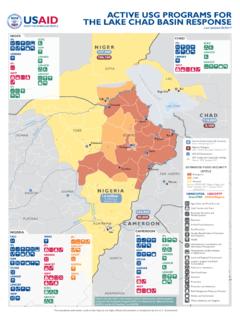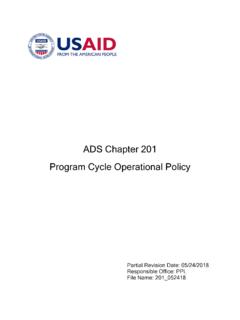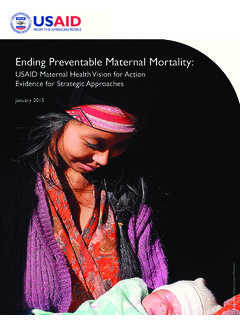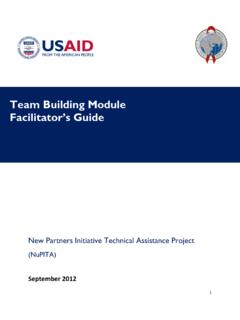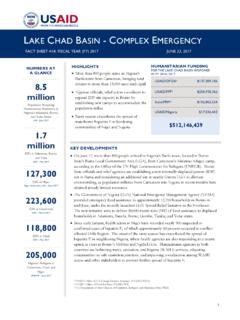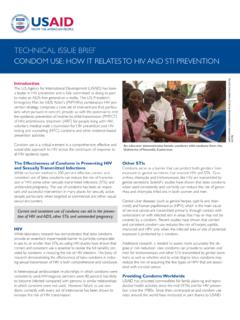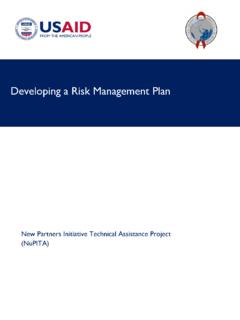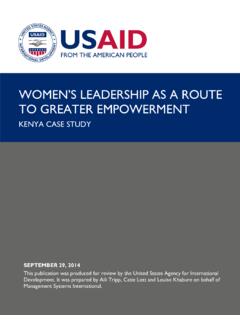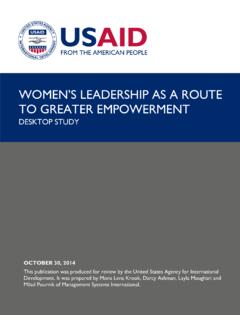Transcription of Youth in Development Policy
1 Photo: Shah Marai Youth IN Development USAID Policy . Realizing the Youth . Demographic Opportunity OCTOBER 2012. [T]here are underlying dynamics that are affecting young people everywhere changes in demographics and technology, economics and politics that are bringing together this unique moment in history. Young people are at the heart of today's great strategic opportunities and challenges, from rebuilding the global economy to combating violent extremism to building sustainable democracies.. Secretary of State, Hillary Rodham Clinton, Youth Rising, Tunisia, February 25, 2012. USAID. Youth IN Development . Policy . Realizing the Demographic Opportunity OCTOBER 2012. WASHINGTON, DC. PD ACS 999. iii iv Youth in Development Policy Contents CONTENTS. Message from the Administrator.
2 Vi Acknowledgements .. vii Executive Summary .. 1. I. Introduction: Youth in Development .. 3. II. Challenges and Opportunities:A Global Snapshot .. 5. III. Goal and Objectivies .. 9. IV. Objective One: StrengthenYouth Programming, Participation, and Partnership . Framework and Guiding Principles .. 11. V. ObjectiveTwo: Integrating and MainstreamingYouth.. 15. Roles and Coordination.. 18. Conclusion .. 19. Annex A: Factors for Selectivity and Focus.. 20. Annex B: Project Specifics: IllustrativeYouth in Development ProjectTypes .. 22. Annex C:Top 40 USAID Countries: Rapidly Growing and Bulging Populations as % ofTotal, 2010 .. 24. Bibliography .. 25. v Message from the Administrator Youth in Development Policy MESSAGE FROM THE ADMINISTRATOR. I am pleased to share with you USAID's first Policy on Youth in Under this Policy , we place a strong emphasis on integrating Youth Development .
3 Building on the Agency's decades of experience considerations as a cross cutting factor in all our programming. working with young people, this Policy provides guidance on pur We also stress the importance of building diverse partnerships suing smarter, more innovative, and more cost effective and fostering innovation with and on behalf of young people, and approaches to empowering Youth to contribute to and benefit the need to better evaluate our Youth programming. The Policy from their countries' Development efforts. In so doing, we seek to highlights the need for new research , particularly around Youth , accelerate economic growth, strengthen societies, and respond to food security and climate change where evidence in more limited. the needs and aspirations of young people everywhere.
4 While this Policy is framed around the complex Youth transition from adolescence to adulthood, it also addresses the important No challenge is more important. Last year, world population sur synergies with childhood interventions, including in health, protec . passed seven billion people, more than half of whom are under tion, education, and nutrition. the age of 30. Changing age structures can provides the opportu . nity to benefit from a so called demographic dividend. As With the release of this Policy , USAID reaffirms its commitment children live longer and family sizes decrease, the share of those to empowering young people with the tools they need to create people in working ages grows in comparison to the very young a more prosperous and peaceful world for us all. or very old.
5 Coupled with strategic, evidence driven and results . oriented investments, this phenomenon can add as much as two percentage points of growth for years. This is especially true in today's world of rapid transformation and connectivity, where Youth serve as energetic change agents in their communities and countries. But there is nothing inevitable or automatic about achieving this Rajiv J. Shah promise. Young people must be given the skills, resources and Administrator opportunities to succeed through quality education, access to health care, adequate nutrition, supportive families and social net . works, and the promise of good jobs. If so, they can be proponents of stable democracies, strong societies and prosper . ous economies. If not, there is another, less hopeful vision: where a large part of the population in developing countries is unem.
6 Ployed, frustrated, volatile, and subject to the siren songs of warlords, crime kingpins and traffickers in persons alike. vi Youth in Development Policy Acknowledgements ACKNOWLEDGEMENTS. A PolicyTaskTeam (PTT), chaired by Nicole Goldin from the This Policy is also the result of robust consultations across the Bureau for Policy , Planning, and Learning (PPL) with Mark Han Agency and interagency, as well as with interested Congressional nafin from the Bureau for Democracy, Conflict and Humanitarian staff, external practitioners and partners, and Youth themselves. Assistance (DCHA)/Executive Secretariat, produced USAID's With collaboration from partners, we engaged over 150 young Policy onYouth In PTT comprised seven indi people in 15 countries and over 100 contribu . viduals from across the Agency for their recognized knowledge tions substantially informed and improved this final are and expertise on these issues.
7 These USAID staff worked inten grateful to Deputy Administrator Donald Steinberg for his com . sively and collaboratively in service to this critical Policy , and will mitment to this Policy and the young people it serves. continue to serve as important resources in the Policy 's imple . mentation: As we move to implement this Policy , we intend to embrace feedback on how to ensure the Agency is achieving maximum Christine Capacci Carneal (Middle East and Asia Bureaus) impact and sustainable partnerships with host countries, other Clare Ignatowski (Bureau for Economic Growth, Education donors, young people, and a wide range of Youth practitioners. and the Environment). Cate Lane (Bureau for Global Health). Erin Mazursky (Bureau for Legislative and Public Affairs). Mark Meassick (Mission/Kenya).
8 Enrique Roig (Bureau for Latin America and the Caribbean). Jennifer Watts (Bureau for Policy , Planning, and Learning). The PTT held a series of internal and external listening sessions, as well as a review of the knowledge and evidence base for inter . national Youth Development and relevant lessons from domestic experience. Early drafting was further informed by Washington and mission resource groups, and we thank them for their thoughtful feedback and would also like to acknowledge Devon McLorg, a Presidential Management Fellow for providing critical support to theTeam in the final months. vii viii Youth in Development Policy Executive Summary EXECUTIVE SUMMARY. This Policy on Youth in Development is the first of its kind for Objectives USAID. It is both timely and necessary as more than half of the world's population today is under the age of 30, with the 1: Strengthen Youth programming, participation and partner.
9 Vast majority living in the developing world. As Secretary ship in support of Agency Development objectives. Clinton said in Tunisia in February 2012, in every region, 2: Mainstream and integrate Youth issues and engage young responding to the needs and aspirations of young people is a people across Agency initiatives and operations. crucial challenge for the future. The Policy is predicated on emerging best and promising practice for Youth develop . ment and engagement that are gleaned from USAID and Expected Outcomes partner's experience in Youth programming, as well as Youth are better able to access economic and social through consultations with young people across the develop opportunities, share in economic growth, live healthy lives, ing Policy is further informed by principles and and contribute to household, community, and national practices articulated in the Presidential Policy Directive on well being.
10 Global Development (PPD), the Quadrennial Diplomacy and Youth fully participate in democratic and Development Development Review (QDDR), the National Security Strategy 2010, State Department Youth Policy 2011, USAID Forward, processes, play active roles in peace building and civil soci . and the USAID Policy Framework 2011 2015. ety, and are less involved in Youth gangs, criminal networks, and insurgent organizations. USAID has decades of valuable experience in leading efforts Youth have a stronger voice in, and are better served by with young people and societies to enable safe and produc local and national institutions, with more robust and Youth . tive transition of Youth to adulthood. However, USAID has friendly policies. not always approached its work with Youth systematically.

